Table Of Content
Here, seven Googlers past and present, share how Design Sprints became the primary engine for innovation at Google—and beyond. The sprint is a five-day process for answering critical business questions through design, prototyping, and testing ideas with customers. Developed at GV, it’s a “greatest hits” of business strategy, innovation, behavior science, design thinking, and more—packaged into a battle-tested process that any team can use.
Working and Living Abroad as an International Designer
Design Sprint Challenge - JCU Australia - James Cook University
Design Sprint Challenge - JCU Australia.
Posted: Sat, 13 May 2023 23:38:19 GMT [source]
We’ve generally found that people are eager to answer questions and discuss their experiences, but there are techniques that facilitate a smooth conversation. In order to break the ice and politely get close to people, introduce yourself and explain you’re running a quick research study. Then ask for the interviewee’s name and 15 minutes of their time. Sketching solutions collaboratively with end-users can help generate innovative ideas.

Phase 2: Looking for solutions
Dubai CAV design sprint - Buro Happold
Dubai CAV design sprint.
Posted: Tue, 13 Dec 2016 08:00:00 GMT [source]
It's a distilled and concentrated methodology based on Design Thinking and Agile principles, developed by Google Ventures (GV) and enhanced by practitioners worldwide. In the Define phase, the team uses everything they learned in the Understand phase to zero in on a specific focus for the sprint. Design sprints are an effective processes used by teams to solve complex problems in a short period of time. Learn how to plan and facilitate the six phases of a design sprint.
Validate
The lynchpin of a Design Sprint is the Sprint Leader; without a leader, it’s just a brainstorm. When sprint fever started to take off, the small team of people who’d been leading sprints found themselves spread thin. It was clear that Google needed to train more people to be sprint leaders, so they launched the Sprint Leadership Academy in 2014. Calendars are packed with meetings and “syncs.” To-do lists are never-ending. And that makes it really, really hard to find time to work in a focused way on anything.
Saves your settings and preferences, like your location, for a more personalized experience. Governs the storage of data necessary for maintaining website security, user authentication, and fraud prevention mechanisms. Since the release of the Agile Manifesto in 2001, agile methodologies have become almost unrecognizable in many organizations, even as they have become wildly popular.
Design sprints were first created in 2013 at GV (formerly known as Google Ventures), the venture capital investment arm of Alphabet Inc. This content has been made available for informational purposes only. Learners are advised to conduct additional research to ensure that courses and other credentials pursued meet their personal, professional, and financial goals. Enables personalizing ads based on user data and interactions, allowing for more relevant advertising experiences across Google services.

Before anything, we’ll need to confirm the interview times with the user testers. As mentioned earlier, aim to start them at around 10–11 AM so that we have enough time to review the interviews (and the effectiveness of the overall design sprint) afterward. Next, we’ll need to prepare the storyboard for prototyping by increasing the fidelity. It’s best if the designer recreates the chosen storyboard as a high-contrast wireframe, as we don’t want to overthink the design due to our time constraints.
Try a design sprint on your next design project
And without momentum it’s difficult, if not impossible, to get an idea off the ground. Keep groups to five to seven people, and break larger teams into small groups that are all working on the same problem. More people creating and iterating means more ideas and multiple versions of a prototype. Google recommends that you use Keynote and the available templates on Keynotopia to rapidly build interactive prototypes.
Navigate the 5 stages of business growth for ultimate success
Design sprints can help you achieve the desired results in a short period, allowing your team to focus on the prioritized goals defined in advance. Agile approach and product design sprints’ nature enable enhancing productivity, using multiple power tools and techniques, and establishing a user-centered approach. In design sprints focused on building more complex and mature products, the final stage often requires real users’ involvement.
The team collaborated with drivers for Go-Jek, an Indonesian company that offers rides and delivery services via motorbike. When sketching solutions, Go-Jek drivers were able to draw on first-hand experience to contribute novel ideas. On Monday, you’ll map out the problem and pick an important place to focus. On Wednesday, you’ll make difficult decisions and turn your ideas into a testable hypothesis. A project manager is responsible for tracking the team’s progress, organizing the meetings, and controlling time management efficiency. Such professionals play the role of facilitators in design sprints, establishing a productive environment to reach the sprint goals.
An audio or video call is perfectly fine; any method that helps get the sprint team all the info they need. Once a prototype is built, it’s time to test it with potential users; the goal is to access unbiased feedback. Labs or offices may feel intimidating to participants, so we recommend conducting intercepts—short, 15 to 30 minute interviews—with people in everyday places like parks and cafes. These environments typically put them at ease, resulting in more authentic feedback. Intercepts also allow for non-researchers like product managers or engineers to conduct interviews, enabling first-hand observations of the prototype.
You can make the final selection by discussion, dot-voting, or even simply having the most suitable person to choose the idea(s) to pursue on behalf of the whole group. On day three, you decide which idea(s) you believe the most in. Depending on the number of ideas generated on day two, ask each participant to choose one or a few of their ideas. Share these individually-brainstormed ideas with the whole group to get further inspiration from each other and build on top of their ideas. Repeat the cycle two or three times until your ideas are refined. Start by giving participants some time to do benchmarking and find exciting solutions that already exist out there.
Google’s Design Sprint Kit offers a way to connect more deeply with potential users, while making problem-solving for the right issues a key part of the creative process. The flexible six-phase framework—Understand, Define, Sketch, Decide, Prototype, and Validate—allows for direct collaboration and testing in a matter of days. Successful sprints generate enthusiasm and thoughtful forward momentum.


No comments:
Post a Comment